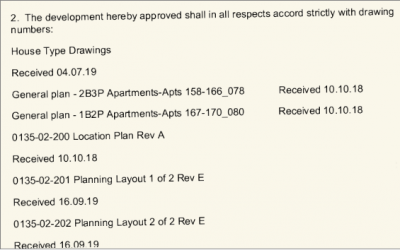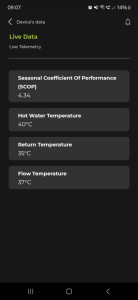Controversial opinions - pure weather compensation, buffer tank, heat loss, oversized heat pumps
Posted by: @uk_pete_2000Our EPC (taken from SAP, new house build) showed 8,300kwh.
Ah... that's interesting.
As it's a new build, is it by one of the major national housing developers who offer a NHBC warranty?
If so, then they have an 'agreement' which allows them to pre-register a site before they even apply for Outline Planning Consent.
A site close to me was registered for Building Control purposes, over 5 years before Bovis even purchased the land.
At the point the site is 'registered' with NHBC, the clock stops moving for both Building Regs and SAP Assessments.
The developer is 'allowed' to build houses to the standards which existed at the registration date.
This won't be shown on your SAP certificate.
You need to ask for the multi-page printout of the SAP calculations.
The SAP software version number and the Licence Number of the assessor is printed at the foot of each page.
You may also discover that the SAP calculations have been performed on building fabric/materials which differ from the house you've finally purchased.
Both Building Regs approval and SAP scores are based on the Approved Drawings which are listed in Section 2 of the Planning Permission.
The SAP rating isn't updated if the site manager changes the design or building fabric when the house eventually gets built.
All too often, they don't bother re-applying to the Local Planning Authority for a Variation.
Very few people ever check their house against the original drawings and Conditions imposed by the Local Planning Authority.
If there have been changes which weren't approved by a Variation Order issued by the LPA, then you have the right to complain to the Council.
They will instruct a Planning Enforcement Officer to undertake a site visit.
Posted by: @heatgeekYou previously indicated that you have a passive house (<10W/m2 or ~5kW peak loss) but it now seems that you actually have a previous standard new build.
That's @heatgeek saying the same thing as I've just explained.
We are both suspecting that you've been sold a house with 'ratings' that aren't for the current standards.
Save energy... recycle electrons!
Posted by: @heatgeek@uk_pete_2000 I think we have some misunderstandings here. You previously indicated that you have a passive house (<10W/m2 or ~5kW peak loss) but it now seems that you actually have a previous standard new build. Your heat loss could therefore be nearer 20W/m2 or 10kW peak. Allowing a margin for DHW, etc implies that the sizing of your HP is in the right ballpark. This negates all my previous comments as I took it that your peak heat loss is less than the minimum output of your HP. You are focussed on your kWh electricity usage when you should be assessing your kW heat loss. When I mentioned 20kWh for the tank, this was for heat input from the HP. At a COP of 5, this equates to 4kWh electricity input. You cannot plan or change anything unless you have an understanding of your house heat loss in kWs, not kWhs of electricity. Regarding flows, you have 4 manifolds with a flow meter on each loop/radiator, don’t you? What are the l/min readings on these? Does each manifold have a pump/mixer or is there only one post-buffer pump for all? What is the model and speed setting on these pumps? Do you have u-values and dimensions for all walls, floor, roof and windows? What is the pipe spacing on your UFH, screed type and floor covering? You are also operating the heating intermittently which is distorting the value of real heat loss if you only look at the electricity consumed.
It is impossible to give you any suggestions without accurate information.
It's very much passive house and at 538m², with 1300kwh heating (as taken from a meter just for the HP). That works out at less than 2.5kwh/m²/per year. (Passive is 15).
Following on from that, our overall energy usage is 4800kwh per year. Which is even below just heat requirements of passive house.
400mm insulation on walls and part of the roof 0.11 u value.
Triple glazed windows 0.6 u value
400mm insulation under floor 0.07 u value
600mm insulation under flat roof 0.06 u value
0.4 air changes (an?)
The various values i showed for heat loss are there to show how wild a spread of results we got and why we ended up with a 13kw HP.
I know a lot about our house and how it uses energy and forgive me using kwh and not kw. The heat lost on all the calculations are shown in kwh, so i just repeated them. When I think I have the right one it seems it is still wrong.
Edit if I take the 1300kwh, it works out at 3.56kw per day and therefore around 7w per m²
We have three manifolds, (2 for ufh, 1 of radiators). All opened. The radiator manifold does have flow showing for each loop, the other two dont. There is a pump for each one set to a straight level 3. It gave us the best result across the buffer as we could not reduce the HP flow any further than closing a couple of ball valves to half
@uk_pete_2000 Your u-values stack up with the amount of insulation installed. I presume therefore that you also have MVHR. As the peak heat load is way below the minimum power output of the HP, I therefore stick to my assertion that you are wasting your time trying to follow the popular mantra and do “low and slow” with direct heating. There has to be cycling and inefficiency by definition unless you have a giant size heat-dissipating buffer tank to mask it. A thermal store which can take the full output of the heat pump efficiently is the only way. You can then automatically time heating for Cosy off-peaks without relying on solar battery. As far as the pumps are concerned, they should be set to constant pressure mode if you have modern ones like Grundfos UPM3 Auto (recommended method by Grundfos). It will save you energy and manage constant flows if you use thermostats for finer control, as all loops are in parallel.
I have a similar smaller system setup but with small heat pump, thermostats and very large internal thermal mass with 60cm stone central wall. The Heatmiser thermostats have 1C hysteresis and control the heating. The HP remains off for long periods of time due to the thermal mass and runs for extended time as well on low temperature, not too dissimilar to your method, except I never touch it.
Private individual. No affiliation with commercial "Heat Geeks" of same coincidental name.
This has been a very useful/informative case @uk_pete_2000
For the benefit of others who will read this in future, the original overview of the house where Pete tells us he has a 13kW heat-pump is here.
Unknown to you, the Moderator Team has been discussing exceptions to the "low and slow" strategy last week.
We needed to consider the right message to be put across in the new ABC Guide to Heat Pumps.
Save energy... recycle electrons!
This is a really fascinating discussion, it's great to see so many are navigating through this journey and noone seems to have a perfect solution just yet.
Would anyone be willing to answer my question. My heat pump is oversized ideal logic 10kw. Ideal said it themselves. My question is: if heat pump is oversized, should I limit the pump speed, therefore reducing the flow rate below the "designed" flow rate? Main reason being the dt is only ever 2-3c and even though it's running pure wc it's cycling at least twice an hour. It gets to temperature far too fast and always overshoots. I've got a video call with ideal tomorrow to discuss their thoughts but sadly they seem to be sticking to the instruction manual for now. Hopefully their engineer will shed some light.
Posted by: @ajbevsterMy question is: if heat pump is oversized, should I limit the pump speed, therefore reducing the flow rate below the "designed" flow rate? Main reason being the dt is only ever 2-3c and even though it's running pure wc it's cycling at least twice an hour.
I can't see why that would help. Your heat pump cycles because the demand is less than it's minimum output. The minimum output won't change by changing the flow rate (because it's determined by the compressor) and the demand is set by the house not by the heat pump. Lower deltaT is a good thing because it means you can run at a slightly lower ft so greater efficiency. Cycling twice an hour isn't that bad.
Obviously ideal may have some specifics in the engineering that suggest an alternative way to work, but based on the fundamentals there isn't much you can change that will make a difference.
4kW peak of solar PV since 2011; EV and a 1930s house which has been partially renovated to improve its efficiency. 7kW Vaillant heat pump.
Posted by: @ajbevsterit's cycling at least twice an hour. It gets to temperature far too fast and always overshoots
Normally I don't like asking lots of questions, but here we may need some more information -
Do you have a buffer/low loss header or volumizer in the system ?
if its a buffer/low loss header, have you taken any temperature readings from the in/out ports ?
It's the small delta that's going to cause the cycling, which can be caused by any number of things.
@uk_pete_2000 yes it's a gledhill 300L + 72L internal buffer tank. Sadly can't access in out ports but flow and returns are normally 37-35 /46-43 etc.
Sadly the dhw thermostat wasn't installed correctly either so that gauge is way off currently.
My thoughts are running it at a lower flow rate will help heat transfer...only way I can achieve is by reducing max pump speed (seems to only ever run at 100%) the compressor modulation sorts itself out.
I'm just trying to find out what exactly setting the ideal logic on quiet mode actually does. Might be a trial and error, but my confusion is, why have a setting to run on quiet mode and tell the installers never to use it...as its an oversized pump, getting up to temp is no problem, surely if this keeps the speed down it will help it run for longer and work less hard?
Posted by: @ajbevsteryes it's a gledhill 300L + 72L internal buffer tank. Sadly can't access in out ports but flow and returns are normally 37-35 /46-43 etc.
Cheers, I think the 72l one can be ignored, could be there as a volumizer and shouldn't effect flow/return.
Is the Gledhill your DHW system ?
Not sure what those reading represent without some content of where they are from
Yes it's a unvented cylinder and does the central heating and dhw.
- Apologies, the sensors are on the flow pipe coming in and return leaving the house right by the exterior wall is where the thermistors are connected to the pipes.
I have a video call booked with ideal today to go over the installation and best settings. As you can see from the pic something not quite right...hot water temp is more like 50c coming out of tap (separate issue)
I get the feeling that the only real way to figure out most efficient for my property is trial and error. Especially if the system hasn't been surveyed properly. A lot of cowboys on the eco4 scheme sadly.
- 26 Forums
- 2,360 Topics
- 53.5 K Posts
- 170 Online
- 6,026 Members
Join Us!
Worth Watching
Latest Posts
-
RE: My Powerwall 3 Consumes 3-4 kWh/Day in Self-Consumption: Is This Normal?
@f1p Might be normalmy numbers 3+ year old powerwall 2,...
By ksim , 35 minutes ago
-
RE: Mitsubishi Ecodan R290 10kW performance
@sheriff-fatman This is the table that I am familiar wi...
By Ecoste , 8 hours ago
-
RE: New Fogstar 15.5kWh upright solution
SITREP #5 (I think) Milestone completed toda...
By GGW , 12 hours ago
-
RE: Octopus Cosy Heat Pump Owners & Discussion Thread
The FT levels off at either the set point OR the minimu...
By AndrewJ , 12 hours ago
-
RE: MyVaillant Connect Regular Disconnect
Thanks. Yes, if the time is consistently 11pm every nig...
By buckwem , 12 hours ago
-

RE: Speedcomfort radiator fans
My take on Speedcomfort radiator fans: If anyone w...
By Mars , 18 hours ago
-
RE: Midea ASHP – how to set weather compensation
@pash44pump I have yet to come across any Clivet or Mid...
By benson , 18 hours ago
-
RE: Who's your electricity provider and what's your tariff?
@transparent Thanks, this helps. Could it be that St...
By Batpred , 19 hours ago
-
RE: Clivet ASHPs and weather compensation
Simon did share a lot of very helpful advice. On furthe...
By ambris , 19 hours ago
-
RE: Home Assistant vs ESPAltherma.
@majordennisbloodnok Thanks very much.
By Ubert767 , 20 hours ago
-

RE: Setback savings - fact or fiction?
I could, but I think we can do better, by plotting hour...
By cathodeRay , 2 days ago
-
RE: Advice on internal circulation pump noise
Extend the primary branch and make sure you have more t...
By ASHP-BOBBA , 2 days ago
-

RE: External pipework insulation
Oh Dear! that's appalling pipe work, should've been in ...
By dgclimatecontrol , 2 days ago
-

RE: Jokes and fun posts about heat pumps and renewables
By Morgan , 2 days ago
-

RE: Controlling Daikin Altherma via P1P2 and Home Assistant
On the contrary, @toodles, that’s a lot of help. I’d ne...
By Majordennisbloodnok , 2 days ago
-

Parsnip, Bacon & Coconut Milk Soup
First let me say, I am only a cook because I am human a...
By Toodles , 2 days ago
-
RE: Electricity price predictions
Ben Watts posted on LinkedIn that he had updated this w...
By Judith , 3 days ago
-

RE: The good, the bad and the not that great – my heat pump installation
Small update, Emailed and Spoke to Midea UK and they ...
By Burtis , 3 days ago







